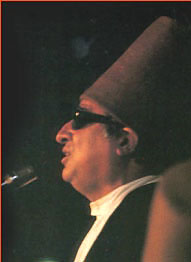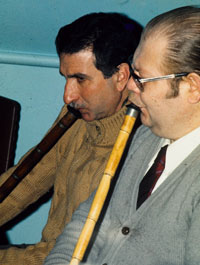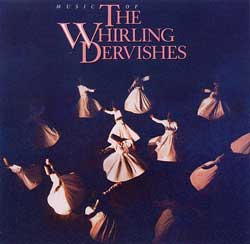|
Breathy sound
Aka's
ney sound was ideal for dervish music. His breathy tone quality reminds me
of the raspy breathing that dervishes make when they reach an advanced state
of rapturous dancing and rhythmic breathing, or zikir (" La
ilahe illallâh," Trk., [There is] no God but Allah).
 zikir zikir
Aka especially loved the lowest register of the ney and he
had developed a powerful tone there. In those low tones, Aka's
dark, resonant sound was at its most profound. He liked to linger there,
working the lowest tones, even at times bending
Kaba Rast (the lowest note) a half- or
even a whole-step lower. Aka's
low register has a lot in common with the dark, compelling voice of Kâni
Karaca (right) (click for larger image), for decades the unquestioned leading singer of Sufi music. ney and he
had developed a powerful tone there. In those low tones, Aka's
dark, resonant sound was at its most profound. He liked to linger there,
working the lowest tones, even at times bending
Kaba Rast (the lowest note) a half- or
even a whole-step lower. Aka's
low register has a lot in common with the dark, compelling voice of Kâni
Karaca (right) (click for larger image), for decades the unquestioned leading singer of Sufi music.
 Aka Aka
 Kâni Kâni

Aka's
broad, breathy, dark ney sound, never tongued, was the opposite
of the focused, bright, flute-like
timbre and tongued notes of the slightly more famous ney player of the last third of the twentieth
century, Niyazi Sayın (on left in photo) (click for larger image). Niyazi was perfectly capable of playing in the lowest
range but he never lingered there for long, escaping quickly to the brighter
tones of the middle and upper octaves.
 Niyazi Niyazi
Niyazi may have been the most celebrated of secular Ottoman classical music ney players,
but once Aka came into his own, Aka was designated
Serneyzen (principal ney player) at the annual Mevlâna Festival in
Konya on the anniversary of the death of Celaleddin al Rumi in December, a
signal honor for a ney player because of the
historical association of ney with the Mevlevi (See
Feldman 1996).
Aka
also made several recordings of the Mevlevi ritual music as soloist with Kâni, the
best recording of which is the now out-of-print "Music of the
Whirling Dervishes"
CD on Atlantic label (left) (click for larger image).
home | Ney making
last revised 21 September 2008
|
 ney and he
had developed a powerful tone there. In those low tones, Aka's
dark, resonant sound was at its most profound. He liked to linger there,
working the lowest tones, even at times bending
Kaba Rast (the lowest note) a half- or
even a whole-step lower. Aka's
low register has a lot in common with the dark, compelling voice of Kâni
Karaca (right) (click for larger image), for decades the unquestioned leading singer of Sufi music.
ney and he
had developed a powerful tone there. In those low tones, Aka's
dark, resonant sound was at its most profound. He liked to linger there,
working the lowest tones, even at times bending
Kaba Rast (the lowest note) a half- or
even a whole-step lower. Aka's
low register has a lot in common with the dark, compelling voice of Kâni
Karaca (right) (click for larger image), for decades the unquestioned leading singer of Sufi music.
